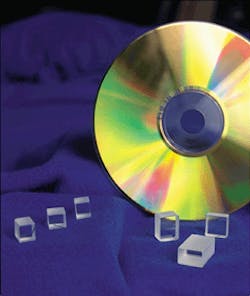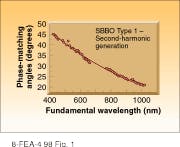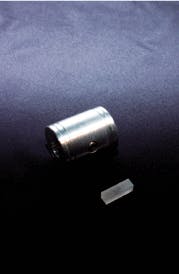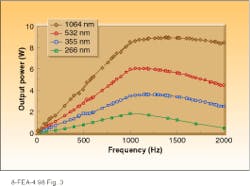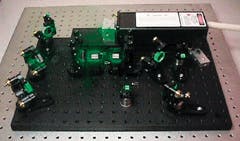Deep-UV applications await improved nonlinear optics
Potentially lucrative applications for deep-UV (ultra violet) laser light sources, such as 193-nm photolithography, solid-state systems for photorefractive keratectomy (PRK), and industrial machining applications are stimulating high levels of interest and effort toward developing nonlinear optical materials for deep-UV generation. Unfortunately, the highly competitive environment also causes many of the players to be closemouthed about their efforts. Based on what people are willing to talk about, however, the field can be roughly divided into two halves by what Peter Schunemann at Lockheed Sanders (Nashua, NH) describes as a "200-nm wall in terms of deep-UV generation."
Cesium lithium borate (CLBO) is transparent at wavelengths below 200 nm (down to 180 nm), but it does not have enough birefringence to directly double to wavelengths below 200 nm. Lithium triborate (LBO) is transparent down to 155 nm, but does not phase-match. Beta-barium borate (BBO) transmits down to 189 nm, but it only phase-matches down to 205 nm for direct second-harmonic generation. "So you might be able to frequency-mix a little below 200 nm," Schunemann says. "But you get so close to the band edge that you`re going to have lots of nonlinear absorption."
But practical nonlinear materials for direct frequency doubling into the deep-UV simply don`t exist; Gary Catella at Cleveland Crystals (Cleveland, OH) refers to the compounds under investigation for that purpose as "unobtainium." He also adds (as does just about everyone else) that his company is also looking into aspects of deep-UV generation that it can`t talk about. So one can`t rule out the possibility that the actual pursuit of "unobtainium" derives some measure of participation and support from individuals or groups who may not yet be ready to admit it.
Promising beryllium
Admitted seekers after a crystal to provide direct frequency doubling into the deep-UV include Schunemann, Douglas Keszler at Oregon State University (Corvallis, OR), who holds the patent for CLBO, and Chuangtian Chen of the Fujian Institute (Fujian, China). Chen developed potassium beryllium borate fluoride (KBBF), the first of these materials that was transparent down to 155 nm and phase-matchable to 185 nm and thereby provided a seemingly clear route below 200 nm. A problem arose in the material`s platelike crystals, Schunemann says. "They formed a layered structure, and the individual layers were very weakly bonded. So it was difficult even to grow crystals thicker than a couple of millimeters. And even then they weren`t very robust."
Subsequently Chen`s group developed strontium beryllium borate (SBBO), which was first reported in 1995.1 Additional papers were published and a patent has been issued for this material with outstanding properties in just about every category except availability (see Fig. 1). "It`s quite hard and is not hygroscopic," Schunemann says. "It`s transparent down to 155 nm and phase-matchable down to 177 nm. Its D [D22 nonlinear] coefficient is 1.5 picometers per volt."Unfortunately, these crystals are also very difficult to grow. Chen`s group has only been able to get small crystals on the order of 5 × 5 × 4 mm, according to Chen.2 And apparently even in those crystals there is a lot of scattering and the optical quality is bad. Schunemann says he learned about the poor optical quality in a discussion with Chen at CLEO `98 (San Francisco, CA). "You send a HeNe in and you get a cone of light out," Schunemann says.
Undaunted, Schunemann has begun trying to reproduce Chen`s results while simultaneously working on a related compound—strontium aluminum borate. Neither crystal is proving easy to grow, which is not surprising, because if they had been easy to grow Chinese companies would already be selling them, Schunemann says. Nonetheless, he optimistically projects that device-quality crystals might emerge in about a year. "It`s not as bad as I thought it would be," he says. "When you try to grow LBO, the flux is extremely viscous. So that`s a big hurdle to overcome when you are trying to grow crystals. But the flux systems they use for SBBO are quite reasonable in terms of viscosity."
Ten years and $10 million
If a device-quality crystal is produced in the next year, it will constitute only one of the initial steps in the 10-year, $10 million process required to bring a new crystal idea out of the laboratory and into "some remotely useful condition" for full commercialization—according to a rule of thumb that Gary Catella says he first heard at Lawrence Livermore Laboratory (Livermore, CA). He points to BBO as a case in point (see photo). "It has a wonderful selection of properties and a few things about it that could be better, but it took several years before it could be brought to the point where small quantities could be made commercially available," he said. "That was about 10 years ago [when Cleveland Crystals was] the first commercial supplier of BBO in the USA. And it still requires a significant level of effort to provide ultraviolet-grade BBO that we consider appropriate for very difficult ultraviolet applications."
If Catella is right, none of the beryllium compounds nor any their analogs are likely to be ready in a year or two to provide a solid-state route to 193-nm lithography. Even if the beryllium-based crystals were perfected, solid-state technology would still have a series of high hurdles to jump before becoming competitive with the much-more-mature excimer technology, according to Chuck Hamilton at Aculight (Bothell, WA). This is particularly true at the deep-UV end of the spectrum where degradation of optical materials presents a much grimmer aspect than it does in the infrared. Also, smaller beam sizes in a solid-state system would lead to even higher fluences than the considerable ones that must already be dealt with in excimer lasers. In effect, durability of optics throughout the system would become more of a limiting factor than the availability of efficient nonlinear conversion material, in creating a more-reliable solid-state source for photolithography, according to Sergei Govorkov at Lambda Physik America (Ft. Lauderdale, FL). Indeed funding for Schunemann`s work from Etec Systems, (Beaverton, OR) is with hopes of using SBBO for the mask-making step prior to photolithography as opposed to the photolithography itself, according to Paul Allen at Etec.3
Tough to obtain
On the high side of the 200-nm wall one finds CLBO, which has yet to receive widespread commercial availability and tends to raise divergent views among people who work with it. CLBO draws rave reviews from some people because it has a lower pointing-vector walk-off and greater angular acceptance than BBO, which allows CLBO to handle small beam sizes. CLBO also has more drive than LBO and is suitable for generating 193 nm because of its transparency in that range.
Conversely, Casix (Fujian, China)—which sells CLBO but does not grow it—has seen demand for CLBO diminish, according to Sheng Wu in the US headquarters. Wu attributed the cooling demand partially to the material`s highly hygroscopic nature, which calls for precise environmental control both during growing and during operation and storage, and partially to strains in the crystal structure that can be introduced during the growth process and lead to early crystal failure. While differing somewhat on details, spokespersons from Casix, Crystal Associates (East Hanover, NJ), and Cleveland Crystals—which is researching CLBO but not actively marketing it—all point out that if CLBO can be considered commercially available at all, it can only be considered to be so for a relatively small R&D market (see Fig. 2).Jeff Brunner at Crystal Associates estimates CLBO demand to be on the order of tens to low hundreds per year for that company and maybe several hundred per year for the entire world market. Brunner adds that because Crystal Associates grows its own CLBO, the company could meet a higher demand if one arose.
Lambda Physik (Göttingen, Germany), however, seems to be pushing the 10-year, $10 million timeline for CLBO toward commercialization with the introduction of products such as the Star Line pulsed diode-pumped laser and the tunable 1-kHz Ce:LiCAF laser at CLEO `97 (Baltimore, MD). Optional fourth and fifth harmonics on the Star Line provide 2 W at 266 nm in the laboratory at a 1-kHz repetition rate, which is guaranteed at 1 W commercially (see Fig. 3). At 213 nm the system reaches 1 W at 1 kHz, Sergei Govorkov says. The high acceptance angle and low walk-off of CLBO allow the system to deliver a Gaussian beam profile and a more than 20% conversion efficiency to the fourth harmonic from the 9-W input at 1.064 µm, he adds. The system is used primarily for micromachining applications, and CLBO crystal lifetimes are expected to be on the order of several months. The first installed system has been in trouble-free operation for more than six months, Govorkov says. Lambda Physik manages the key factor of environmental control with a system that, like so many other aspects of this field, remains proprietary because the patent is still pending.Managing the environment
Perhaps unsurprisingly, Gary Catella at Cleveland Crystals advocates, for nonlinear crystals in general, instituting managing methods that extend the operating capabilities of currently available crystals rather than focusing on creating entirely new nonlinear materials for the deep-UV (see Laser Focus World, Dec. 1997, p. 147). This perspective becomes even more crucial in the UV where one is confronted with what Catella describes as the art of keeping the water, oxygen, and ultraviolet light separate from each other at the crystal surface. He applies this argument not just to the extremely hygroscopic and difficult-to-obtain CLBO, but also to LBO, which, despite its moisture resistance, can be difficult to coat, and to BBO, which is easier to coat than LBO. It also has a variety of coating options with varying degrees of coating durability, while also being less hygroscopic than CLBO but is still subject to a lowered UV surface damage threshold in the presence of humidity and oxygen.
"A lot of the art of successful harmonic generators, especially in the ultraviolet, comes not just from sticking a crystal on a post someplace, but from having a properly engineered housing with windows if necessary and AR coatings that can stand up in the ultraviolet," Catella says. Wu also emphasized the importance of crystal-management issues, pointing to the use of 11 coating chambers at Casix (not exclusively for coating crystals) as evidence.
"We`ve worked consistently from the position that a reasonably versatile material like BBO can address many of the applications—certainly down to the fifth harmonic (213 nm)—if you pay attention to the materials and make sure that you have very clear and clean material," Catella said.
CLBO is a good example of a crystal with serious optomechanical problems, he continued. It`s very sensitive to moisture, especially during the fabrication phase. But it can be packaged for protection, once fabricated. It has nonlinear properties interesting enough to make it worth pursuing, however, and may enable frequency conversion deeper into the UV than BBO. The issue usually comes down to properly matching the characteristics of the drive laser to the available nonlinear materials. And that match often plays a greater part in the ultimate conversion efficiency than the choice of any particular material.
Practical examples
Researchers at Aculight demonstrated this flexibility of materials in an all-solid-state 193-nm laser design in which either LBO or CLBO can be used in the final 193-nm stage for sum-frequency mixing of 2.1 µm with the 213-nm harmonic (see Laser Focus World, Jan. 1998, p. 113). More recently, Photonics Automation (Soquel, CA) has produced an all-solid-state 193-nm metrology prototype with four nonlinear stages instead of five. This was accomplished by mixing a 703-nm signal from an optical parametric oscillator in a potassium titanyl phosphate (KTP) crystal with the 266-nm fourth harmonic of a Nd:YAG laser. The fourth harmonic of the OPO pump laser was obtained by quadrupling in CLBO (see Fig. 4).Last April on the other side of the 200-nm wall, researchers at Lightwave Electronics (Mountain View, CA) completed an SBIR Phase 2 program with the Philips Laboratory (Kirtland AFB, NM) to develop a diode-pumped, solid-state CW 266-nm source at a 100-mW power level. The system basically consists of a 2-W diode-pumped Nd:YAG laser that was externally resonantly doubled in MgO:lithium niobate to generate 532-nm light, then externally resonantly doubled again in BBO to generate CW 266-nm light for an overall conversion efficiency from the diode laser output to the UV of about 8%. A major factor in producing the system successfully was low-optical-loss BBO obtained through a cooperative agreement with Sony Precision Technology (Tokyo, Japan). Sony showed an all-solid-state 266-nm laser at CLEO `98.
High-quality BBO with low optical loss was essential to the success of the design, according to David Gerstenberger at Lightwave Electronics. Other important aspects of the program included a low-loss optical cavity, high-quality optics, tuning the cavity to resonance with the green frequency, and locking it to maintain stable, long-term, low-amplitude noise performance.
On the surface, these examples seem as far away from pursuing "unobtainium" as one could get. Yet even in cases where the 200-nm wall is not a factor, proprietary issues often arise. When asked for more information about Sony`s BBO material, Gerstenberger offered a Sony flier for the 266-nm laser and said, "I don`t think [the BBO] is for sale to the public." A query about the BBO, sent to the e-mail address on the flyer, has received no response at press time. o
REFERENCES
1. C. Chen et al., Nature 373, 322 (Jan. 26,1995).
2. C. Chen et al., CLEO `96 Technical Digest 9, 229.
3. P. C. Allen, "Laser pattern generation technology below 0.25 microns," SPIE Optical Microlithography Conference, Feb. 1998.
About the Author
Hassaun A. Jones-Bey
Senior Editor and Freelance Writer
Hassaun A. Jones-Bey was a senior editor and then freelance writer for Laser Focus World.
